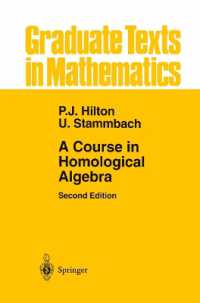Full Description
In Giannozzo Manetti's New Testament Annet den Haan analyses the Latin translation of the Greek New Testament made by the fifteenth-century humanist Giannozzo Manetti (1396-1459). The book includes the first edition of Manetti's text.
Manetti's translation was the first since Jerome's Vulgate, and it predates Erasmus' Novum Instrumentum by half a century. Written at the Vatican court in the 1450s, it is a unique example of humanist philology applied to the sacred text in the pre-Reformation era. Den Haan argues that Manetti's translation was influenced by Valla's Annotationes, and compares Manetti's translation method with his treatise on correct translation, Apologeticus (1458).
Contents
Introduction
1. Manetti's life and works
1.1 Introduction
1.2 Florence
1.3 Rome and Naples (1454-1459)
1.4 Manetti, Bessarion and Valla
1.5 Conclusions
2. Writing process
2.1 Introduction
2.2 Manetti's library
2.3 Sources (vorlage)
2.3.1 The Latin Text
2.3.2 The Greek Text
2.3.3 Manetti's request for Biblical manuscripts
2.4 Revising the vulgate
2.5 Manetti's working copy: Pal.lat.45
2.6 Manetti's redactions of Pal.lat.45
2.6.1 Consistent replacements
2.6.2 Stylistic changes
2.7 Valla's Annotations
2.7.1 Proving Valla's influence
2.7.2 The relevance of Valla's influence
2.8 The New Testament and Adversus iudaeos et gentes
2.9 A later copy: Urb.lat.6
2.9.1 The Urbinate manuscripts
2.9.2 The text of Urb.lat.6
2.10 Conclusions
3. Textual criticism
3.1 Introduction
3.2 The Greek tradition
3.3 Latin readings and writing errors
3.4 Jerome, Bessarion and Valla
3.4.1 Jerome
3.4.2 Bessarion
3.4.3 Valla
3.4.4 A 'conservative' reading: 1 Corinthians 15: 10
3.5 Conclusions
4. Translation theory from Antiquity to the Renaissance
4.1 Introduction
4.2 Classical Antiquity
4.3 Jerome
4.4 Middle Ages
4.5 The first humanists
4.6 Leonardo Bruni
4.6.1 Bruni's Prefaces
4.6.2 Bruni's De interpretatione recta
4.7 Conclusions
5. Apologeticus
5.1 Introduction
5.2 The inspiration of the Septuagint
5.2.1 The Septuagint: early accounts
5.2.2 Jerome
5.2.3 Augustine
5.2.4 Manetti's view
5.3 Apologeticus v
5.3.1 Part One: definition and requirements
5.3.2 Part Two: strategies and genres
5.3.3 Manetti's theory and the method of the Seventy-Two
5.4 Legitimizing new translations: Manetti and Valla
5.4.1 Valla's philological programme
5.4.2 Valla and Jerome
5.4.3 Poggio's criticism
5.4.4 Manetti
5.5 Conclusions
6. Translation method
6.1 Introduction
6.2 Quantitative representation
6.3 Segmentation
6.4 Word order
6.5 Consistency
6.5.1 Consistency and writing process
6.5.2 Case study 1: mysterium and sacramentum
6.5.3 Case study 2: 1 Corinthians 2: 13
6.5.4 Consistency as a criterion for literalism
6.6 Translation techniques
6.6.1 Borrowings
6.6.2 Periphrastic renderings
6.6.3 Transpositions and modulations
6.6.4 Case study 3: Luke 2: 35
6.6.5 Case study 4: John 15: 26 (a counterexample)
6.7 Conclusions
Conclusions
Appendix: Manetti's library
Bibliography
Index








